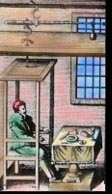August Krogh (1874-1949)
Krogh began his career in the laboratory of the noted Christian Bohr (1855-1911), who himself had been trained by physiologist Carl Ludwig in Leipzig, Germany. Bohr had already clarified the dynamics of muscle contraction and solubility of oxygen in different fluids including blood. His studies of oxygen influenced Krogh's early experiments of tissue respiration in animals. Krogh devised equipment to measure respiratory gas exchange in snails, frogs, and fishes. Krogh's An Account of the Structure and Function of the Lungs and Air Sacks of Birds, the equivalent of a master's thesis (1899), proved oxygen diffused rapidly through the thin pulmonary membranes, while the skin eliminated carbon dioxide. Subsequent experiments in gas transport corrected the prevailing view that lungs were gland-type structure that secreted oxygen and carbon dioxide. Krogh's highly accurate equipment analyzed respiratory gases, and established that pulmonary gas was exchanged by the mechanism of diffusion, not secretion. Krogh stated:
Krogh determined to win the prestigious Seegan Prize* by solving the problem of whether or not free nitrogen or nitrogenous gases were released from the body as a normal by-product of metabolism. In 1906, he proved that gaseous nitrogen remained constant and won the prize. His original approach using respiratory methods to quantify nitrogen dynamics also won fame. It succeeded without using the traditional German method of Liebig, Rubner, and their students who measured nitrogen in ingested food and fluid and excreted nitrogen in feces and urine.
In 1905, Krogh married Marie Jorgensen, a promising medical student and scientist in her own right.** The husband-wife team researched transport of carbon dioxide in the lungs, metabolism of Eskimos (with Benedict), and insulin's role in the body. Together, they published seven important papers known as the "seven little devils." Their experiments disproved the oxygen secretion hypothesis championed by Krogh's early mentor, Christian Bohr. Krogh invented the microtonometer, indispensable for quantifying gas transport in blood. Krogh earned enough money from selling equipment to support his laboratory.
Krogh published nearly 300 research papers (1), many of which we consider "classics" in exercise physiology. For example, he and Johannes Lindhard (1870-1947) studied regulation of respiration and circulation during exercise and recovery. Krogh devised a bicycle ergometer with magnets and weights to quantify exercise intensity. He perfected a method that used nitrous oxide gas to estimate exercise cardiac output. He found that tissues extracted more oxygen during exercise; concurrently, circulation and ventilation increased. Interested in how a muscle receives oxygen, he studied capillary blood flow, as well as oxygen's pressure and diffusing capacity through tissues (1).
Krogh won the 1920 Nobel Prize in Physiology or Medicine for discovering the mechanism that controlled capillary blood flow in resting and active muscle (in frogs; 2,3,4). He chronicled his research in 1922 (5).
Although there are brief reviews of his career (6,7), a biography by August Krogh's daughter (Bodil Schmidt-Nielsen) furnishes the most "up-close and personal" information about the lives of both August and Marie Krogh (1). This Nielsen book is a "must" read; the content provides numerous insights about famous scientists in Europe and the United States with whom the Kroghs collaborated.
August Krogh's research linked exercise physiology with nutrition and metabolism. Experiments in comparative zoology (zoophysiology) and cardiovascular physiology inspired experiments in exercise physiology. Krogh interacted with distinguished physiologists A. Keys, Abbey H. Turner, E. M. Landis, E. H. Christensen, F. G. Kovian, A. M Hemmingsen, H. H. Ussing, and T. W. Fogh. He influenced the next generation of scientists in exercise physiology, particularly those in Nordic countries and the United States. They in turn taught others to investigate human nutrition during acute and chronic physical activity. © Frank I. Katch, William D. McArdle, Victor L. Katch. 1997. *Established by the Imperial Academy of Sciences in Vienna with a cash award of four thousand kroner. **In 1914, she became the fourth Danish woman to earn a scientific doctoral degree in medicine (Dr Med.). References 1. Schmidt-Nielsen, B., August & Marie Krogh. Lives in Science. New York, American Physiological Society, Oxford University Press, 1995. 2. Krogh, A. The rate of diffusion of gases through animal tissues with some remarks on the coefficient of invasion, J. Physiol., 52, 1919. 3. Krogh, A. The number and distribution of capillaries in muscles with calculations of the oxygen pressure head necessary for supplying the tissue, J. Physiol., 52, 1919. 4. Krogh, A. The supply of oxygen to the tissues and the regulation of the capillary circulation, J. Physiol. (London), 52, 457, 1919. 5. Krogh, A. The Anatomy and Physiology of Capillaries, Yale University Press, New York, 1922. 6. Liljestrand, G., and Krogh, A. Acta Physiol. Scand, 20, 109, 1950. 7. Snorrason, E., Krogh, Shack August Steenberg, Dictionary Scientific
Bibliography, Vol VII: 501, Scribner's and Sons, New York, 1973.
Edited
and Webmastered by Will Hopkins. Last updated 13 Aug 97. |
